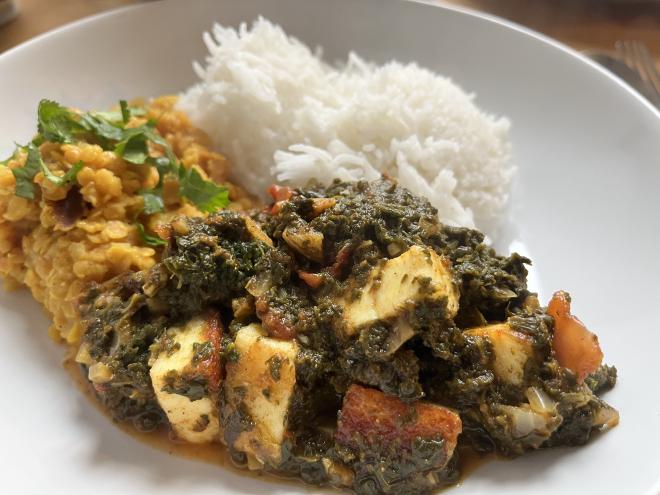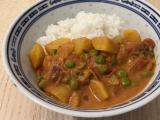- Climate-Friendly Cooking :carrot: /
- Recipes/
- Roopa Gulati's Palak Paneer: Curry with Spinach and Indian Cheese/
Roopa Gulati's Palak Paneer: Curry with Spinach and Indian Cheese
Table of Contents
Jump to Recipe
Jump to Carbon Footprint
Palak paneer is an Indian curry that combines spinach, paneer, and great spices. It is a classic in Indian cuisine and can be found on the menu of any Indian restaurant, but it is also relatively easy to make at home.

The spices roasted in the pan at the beginning give the curry a wonderful flavor. Indian cooks know how to extract incredible flavors from just a few grams of spices.
Paneer can now be found in the chilled section of any well-stocked supermarket. However, it can sometimes be quite firm on the block. A little trick can help: if you dice the paneer, put it in a bowl, pour boiling water over it, and wait for 10-15 minutes, the cheese will soften and become better.
If you don’t want rice as a side dish, you can substitute naan, an Indian flatbread.
This recipe is based on one in India - The World Vegetarian by Roopa Gulati (publisher’s website). Anyone interested in Indian cuisine will find not only great curries in this cookbook, but also an explanation of basic techniques and a separate chapter on Indian breads and savories.
Recipe #
Roopa Gulati’s Palak Paneer: Curry with Spinach and Indian Cheese
45 minutes
2 portions
Ingredients #
- 1 onion
- 2 cloves garlic
- 25 g ginger
- 2+2 tablespoons oil
- 1 teaspoon cumin seeds
- 1 teaspoon cinnamon
- 1 teaspoon tomato purée
- 150 g spinach
- 300 g canned tomatoes
- 1 pinch of turmeric
- 1 pinch of chili powder
- 1 pinch of salt
- 1/2 teaspoon garam masala (cardamom, cinnamon, pepper, cumin, nutmeg)
- 100-150 g paneer (Indian cheese)
- as a side dish: about 120 g of rice
Directions #
- If you are using store-bought paneer, which is quite firm, cut it into cubes and place in hot water for about 10 minutes - this will make it softer and more digestible.
- Peel and chop the onion, garlic, and ginger.
- Heat 2 tablespoons of oil in a large frying pan. Fry the cumin and cinnamon briefly in the oil, then add the onions. When the onions are soft, add the garlic and ginger and cook for about 5 minutes. Meanwhile, add the tomato purée to the pan.
- Wash the rice and bring to the boil with double the amount of water and a little salt, then simmer on a low heat according to the packet instructions.
- Add the spinach to the onion, garlic, and ginger mixture and deglaze with the canned tomatoes. Season with turmeric, chili powder, garam masala, and salt. Cover the pan, bring to the boil, and simmer on a low heat for about 15 minutes.
- Heat 2 tablespoons of oil in a frying pan and fry the paneer cubes until golden brown.
- Add the fried paneer cubes to the rest of the curry, season to taste, and serve with rice.
Carbon Footprint #
In total, two portions of palak paneer (with rice) have an estimated carbon footprint of 2163 g.
This ranks it number 45 out of 57 recipes published on the blog so far in terms of estimated carbon footprint.
This means that at least three quarters of the recipes published here on the blog so far have a better estimated carbon footprint than this recipe. 🙁Looking at the individual ingredients, paneer stands out: it accounts for only about 15% of the ingredients, but more than 40% of the carbon footprint. The production of the 100-150g of paneer in our recipe generates almost 900g of CO2 emissions.
On the other hand, the vegetables used have a very good carbon footprint - for example, the onions, spinach, and canned tomatoes. The spinach scores very well despite the need for a cold chain: growing it is climate-friendly and freezing it also ensures a longer shelf life and less food waste.
| ingredient | carbon footprint per kg | carbon footprint (in g) for 2 servings | % of ingredients | % of CO2 emissions |
|---|---|---|---|---|
| Onion | 0.2 | 16 | 9% | 1% |
| Garlic | 0.5 | 3 | 1% | 0% |
| Ginger | 0.5 | 11 | 3% | 1% |
| Oil | 3.2 | 128 | 5% | 6% |
| Cumin | 1.1 | 1 | 0% | 0% |
| Cinnamon | 1.1 | 1 | 0% | 0% |
| Tomato purée | 4.3 | 22 | 1% | 1% |
| Spinach (frozen) | 0.6 | 90 | 17% | 4% |
| Canned tomatoes | 1.8 | 540 | 35% | 25% |
| Turmeric | 1.1 | 1 | 0% | 0% |
| Chili powder | 1.1 | 1 | 0% | 0% |
| Salt | 1.4 | 3 | 0% | 0% |
| Garam masala | 1.1 | 1 | 0% | 0% |
| Paneer | 7.1 | 889 | 15% | 41% |
| Rice | 3.1 | 372 | 14% | 17% |
| Cooking: Curry | 56 | 3% | ||
| Cooking: Rice | 25 | 1% | ||
| Roast: Paneer | 3 | 0% |


